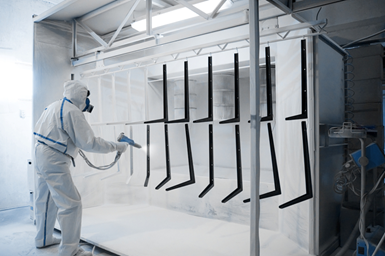Recoating Best Practices
Powder coating consultant Rodger Talbert offers advice for recoating successfully without excess orange peel or inconsistent gloss.
#asktheexpert

Q: We have a pretty good first-pass yield, but we do have some defects related to light coating or other defects that must be sanded and recoated. When we apply the second coat, we sometimes have problems with excess orange peel or inconsistent gloss. We sometimes have problems with inner-coat adhesion, also. Can you offer any advice on best practices to recoat a part and avoid the problems that we are having?
A: It is always a good idea to work hard on first-pass yield to avoid the problems that cause you to recoat. You should consider putting some effort into evaluating the causes of the defects and see if you can reduce them. Light coats and other appearance defects are frequently related to inadequate process controls and operator error. Accurate and consistent gun settings, a controlled environment, good maintenance and understanding electrostatic application can help reduce defects and you will not need to recoat as often. I recommend a training program at your booth suppliers’ facility or by a professional teacher or organization.
Featured Content
When you do have parts that have to be recoated, the first thing that you need to confirm is that the powder material will provide good inner-coat adhesion, with or without sanding. Test it to find out how well the two coats will adhere to avoid that problem. Many powders can be applied directly to the first coat with no issue, but some powders need to be lightly sanded to create a rougher surface for better bond of the second coat. Also, since many lines are run faster than they were designed for, you may run the temperature higher than necessary. If you are running the parts in the oven at a higher temperature you will have more trouble with inner-coat adhesion. Do some testing to figure out the proper cure time and temperature and be certain that the two coats will bond.
For the application of a second coat, there are some simple adjustments to the spray guns that will make it easier to apply and get a consistent appearance. Recoated parts must have 100% coverage to avoid a “dry-spray” look and inconsistent color and gloss. Parts that have been coated once will be more resistant to electrostatic attraction so the electrostatic load line should be adjusted to help overcome the insulating effect of the first coat. Ionization from the gun will build on the part’s surface because there is no simple path to earth ground like there would be with an uncoated part. As the powder begins to build on the surface, the excess ionization will interfere with electrostatic attraction and generate more texture and inconsistent appearance. Powder will have difficulty building near edges and “stars” may appear in the coated surface as the free ions build. This can lead to severe back-ionization and an unacceptable appearance of the powder film. To overcome back-ionization, the current levels must be limited to avoid excess ions from building on the surface. I normally recommend a current level of 20 to 40 micro-amps, but that may vary with different equipment.
A recommended set of adjustments for recoating include a reduction of current levels, a slightly farther gun-to-target distance and a slight increase in flow rates. These adjustments will help with application and consistency. Experiment a little to get the right setup.
It is easier if the recoats are run independently. If you must run the recoats with raw parts you can still reduce the micro-amps a little and make it work better. Another essential key to success is the presence of a good ground connection at all times. It is always important to have good ground to the parts, but it is even more critical for recoats.
Work to reduce rejects that must be recoated. Batch recoats if possible, and be aware that gun settings that work for recoats may be counterproductive on raw parts. Reduce current draw, slightly increase gun-to-target distance and slightly increase flow. That will give you the best possible results.
About the Author
Rodger Talbert
Rodger Talbert began his career in coatings in 1976 when he went to work for a small company that does metal fabrication and custom coating. He worked there for 10 years, rising to the position of VP of Sales and Marketing. He left there to work as a sales engineer for a larger company that designs and builds coating systems, and worked there for seven years. In 1993, Talbert started his own business as a consultant. He ran his own corporation for 15 years before joining The Powder Coating Institute as technical director in 2009. He served as the PCI Executive Director until June 2012.
RELATED CONTENT
-
Film Thickness Control
Have a powder coating job that requires precise film thickness control? Products Finishing columnist Rodger Talbert offers advice controlling the variables that can impact your success.
-
Powder Coating Aluminium Adhesion Failure
PF columnist Rodger Talbert offers advice for mitigating adhesion failure of powder coating on aluminum parts.
-
Hexavalent to trivalent chromium — the environmental benefits
Regulatory pressures to switch from hexavalent chromium to trivalent alternatives are a growing concern for many finishing operations. In this Products Finishing Ask the Expert clinic, Brittany McKinney of Pavco discusses the environmental considerations driving these regulations.




















